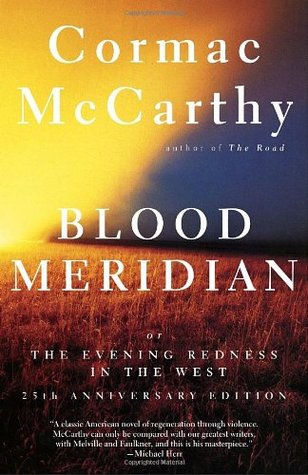I have mixed feelings about this book, which I am pretty sure is exactly the idea. Like other Cormac McCarthy books, the prose in Blood Meridian is great, as long as you can tolerate lots of arcane and antiquated uses for words and don’t require frivolous punctuation like quotation marks and apostrophes. The book is full of evocative descriptions of the desert southwest, from the details of tiny Mexican villages to the size and desolation of the desert. However, that same gorgeous prose is used to describe some of the nastiest violence and depravity that I’ve ever read, so it is absolutely not a joy to read.
The book follows The Kid, who wanders west in the 1840s and gets caught up in a gang of men roving the Mexican border killing and scalping Indians. They quickly realize that it’s awfully hard to tell whether a scalp comes from an Apache or a Mexican, and end up just killing indiscriminately. They go from being hailed as heroes to hunted as monsters.
As far as plot and characters go, this book is pretty weak. The plot is pretty repetitive, and in some places barely makes sense, and most characters are little more than names. In fact, most don’t even have names. Even the Kid, technically the main character, is basically only there to provide a point of view on the events. The only real character is The Judge, fascinating and monstrous both in physical bearing and in deed, who by the end of the book is revealed to be more a symbol than an actual character. The whole book, even though it is based on real historical events, is written in such a way that it feels freighted with symbolism and half-perceived meaning.
When you get down to it, this is less a novel than a treatise on the human love of violence in the guise of a novel so that it is more “palatable” (which, to be sure, is a generous term to use for this book). It is a sort of dialog between the author and the reader that goes like this:
Author: Do you like westerns? Cowboys and Indians? You like the idea of a past when men were men and the frontier was there to be settled by those who could handle its hardships?
Reader: Yes, that sounds great!
Author: Ok, here you go.
Reader: Oh. No, no, that’s horrible! So much death and cruelty. And really, dead babies too? Was that necessary? Why are you showing me this?
Author: You say it’s horrible, but you’re still reading.
Reader: Well, there is some great writing here. But there’s something wrong with you.
Author: The reader dost protest too much, methinks. I think you like it. I think you know you’re supposed to say you hate this but it also excites you. If there’s something wrong here, is it with me, or with you? Or both of us?
This is not a fun book. Both the plot and the characters are lacking. But despite that, having had a few days to reflect on it, I think this is a very good book because it forces the reader to have that internal conversation. This book would probably reveal hidden symbolism and meaning with a second read through, but I don’t have the stomach for it. Heck, I don’t blame people who can’t make it through a first reading. It is not for everyone. You don’t read this for fun, but if you do read it, it sticks with you and makes you think.

